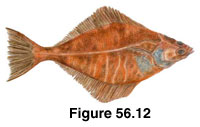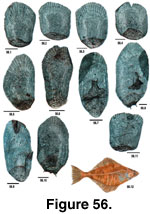 Description
Description
Parophrys (re: Pleuronectes) vetulus (English Sole)
(Other common names: Lemon Sole, Pointed-Nose Sole, California Sole)
Figure 56.12
 Description
DescriptionLength: 57 cm.
Mouth: small, terminal; narrow gape; asymmetrical; maxillary extends to forward edge of lower eye; jaws and teeth strongest on blind side; snout pointed.
Body: slender; caudal peduncle moderate; caudal fin truncate; upper eye visible from blind side; lateral line only slightly arched and with a long accessory branch; pointed pectorals fins.
Color: uniformly brown on eyed side; yellow-white on blind side, with head region being tinged red-brown; fin tips dark.
Depth: up to 550 m.
Habitat: silty to sandy substrates; young can be found in the intertidal regions and shallow waters and move into deeper waters as they grow.
Season: spawn in winter to early spring (December to April).
Diet: crustaceans, molluscs, and polychaetes.
Predators: larger fish species, marine birds (especially on young).
Distribution: central Baja to Alaska.
 Scale Description
Scale DescriptionScale Type: cycloid on both sides of the eyed region and on cheeks; ctenoid posteriorly (Batts, 1964).
Relative Scale Size: small to moderate.
Position of Scales on Body: uniform over the body and on cheeks; absent on fins; imbricated (Hart, 1973).
Overall Scale Shape: mostly oval (elongated lateral fields), but regenerated scales are often circular to square. Area of anterior field is larger than the area of the combine lateral fields (Batts, 1964). There is no bar-like thickening at the base of the ctenii (Batts, 1964).
Focus and Circuli: the focus is positioned approximately 1/4th or greater from the outside margin of the posterior field (Batts, 1964). The circuli are generally continuous between the all the fields in cycloid scales (except where broken by radii) and only continuous in lateral/anterior fields in ctenoid scales (discontinuous in the posterior field for ctenoid scales, Batts, 1964). The circuli are compact and regeneration appears to be more common in ctenoid scales than cycloid scales.
Radii: numbers are variable and not diagnostic. Radii are presently only in the anterior field (Batts, 1964). The outer edge of the anterior field is smooth. Intermarkings absent (Batts, 1964).